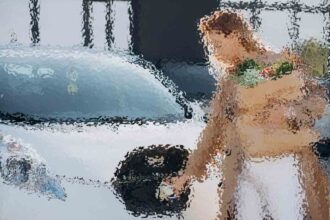After the wedding of a celebrity husband and his much younger wife, media coverage invariably focuses on the inappropriateness of the age gap. Whether it’s the new dad George Clooney (56) and his 18-year-younger wife, Amal, or Donald Trump (70) and his First Lady, Melania (age 47), commentators become psychoanalysts, suggesting that the younger woman is clearly seeking a father figure. Similar stories are triggered by the (much less-common) pairing of a younger man with an older woman, as with 39-year-old French president Emmanuel Macron, and his wife, Brigitte, 64. The rarity of such weddings make them novelties, but not fodder for the same type of speculation.
It’s well known that men tend to marry women younger than themselves, a pattern that leads to increasingly unbalanced male-to-female gender ratios as you move up to older and older age groups. Men also have a lower life expectancy than women, leaving women in the 75-and-up age bracket with fewer and fewer choices of heterosexual partners. An age difference of up to 10 years is generally not looked at askance by anyone who knows how old each partner is, but as that gap gets closer to 20, things start to look a bit more off balance. Once a man is literally old enough to be a woman’s father (or vice versa, for older women), public opinion starts to shift from acceptance to skepticism.
St. Mary’s University’s (Halifax) Sara Skentelbery and Darren Fowler examined the phenomenon of “age gap relationships” (AGRs) from an evolutionary perspective, noting that such pairings have benefits in terms of species survival. A middle-aged or older man pairing with a younger woman, from this viewpoint, ensures that he will continue to have offspring at older ages than would be possible with a peer who is past childbearing age. There are some assumptions within this framework — for example, that people behave in ways that are intended to guarantee the future of the species rather than in response to sociocultural influences. This argument contrasts with the sociocultural perspective, which proposes that negative attitudes involved in ageism and sexism cause older women to be seen as less physically attractive to potential mates.
The sociocultural perspective for understanding the pairing of older men and younger women explains not just that younger women seem physically more attractive to aging males, but that the older man represents socially valued attributes that lead his younger partner to want to bond with him. With age, men may acquire greater power or possess more property, financial and otherwise. The older men with the most appeal to younger women would be those with financial prosperity who are willing to heap some of those financial rewards onto their partner. Meanwhile, these older men believe they’ll accrue even more power and status by sporting their younger, glamorous, and well-outfitted new spouse.
Skentelbery and Fowler wanted to investigate whether it’s true that the women in such pairings were seeking father figures for psychological reasons. Because these relationships are more prevalent when they involve older men and younger women, the authors didn’t perform an analogous study of “mommy figures.” If it’s true that younger women in AGRs are seeking father figures, then it would be expected that they would have maladaptive relationships with their fathers which play out in adulthood by their choice of a mate.
The framework that the St. Mary’s researchers used to test this proposition is attachment theory. According to the attachment theory perspective, people’s adult relationships reflect the way they were treated by their caregivers. Women who need the security of a father figure would, from this point of view, have been poorly cared for by their own fathers, as reflected in later seeking security from an older male. Skentelbery and Fowler therefore sought to compare AGR women with those in SARs (same-age relationships).
Testing their predictions on a sample of 173 women, all involved in a romantic relationship, the study’s authors compared those in AGRs (with a nine-year or larger age difference) vs. SARs (with just one-to-four-year differences). The AGR women ranged from 18 to 53 years old, with partners, on average, 17.3 years older than themselves. Using standard questionnaire measures, the research team asked all participants to rate their attachment styles as well as their relationship satisfaction. As a control to self-report bias, Skentelbery and Fowler also asked participants to complete a measure of “social desirability,” or the tendency to exaggerate one’s positive attributes on a questionnaire (e.g. “I never make a long trip without checking the safety of my car”).
Consistent with large-scale attachment style studies, nearly three-quarters of the sample reported being securely attached. The key comparisons yielded no differences between AGRs and SARs. The two age-based relationship samples were similar in both attachment style and relationship satisfaction. Further, the size of the age gap did not relate significantly to satisfaction with the partner.
It’s risky to account for a lack of differences: Are these non-effects due to faulty methodology or a flawed theory? It’s possible that there were weaknesses in the sample recruitment, as an AGR online forum provided the data for that group; these individuals may not be typical representatives of AGRs. However, if we accept the findings, the Skentelbery and Fowler study suggests that the younger woman-older man relationship has no unique psychological qualities, at least on the measures used.
Relationship fulfillment depends on a host of factors, but according to this study, the age gap alone is not sufficient to predict who will be happiest with whom. That older man (or woman) may just be someone who is a good fit, and, like other couples who defy stereotypes, the pair’s psychological bonding can transcend the demographics.
Do you have a story in your community or an opinion to share with us: Email us at editorial@watchdoguganda.com






